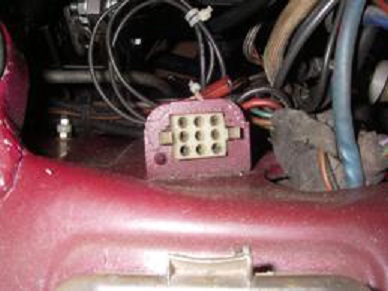Philes’ Forum – Spring 2019
by NJ BMW CCA
By Vic Lucariello, Sr.
Hello Bimmerphiles! This time out I have a couple follow-ups to recent Philes’ Forums, the That Ain’t What It’s For [Spring 2018] column and the Coolant Schmoolant [Summer 2018] column. Archived files of these newsletters can be found at our website NJBMWCCA.org.
In That Ain’t What It’s For, I wrote about the under-dash OBD II diagnostic connector [See Photo #1] and how I, along with some respected, experienced BMW techs, do not recommend using the OBD II connector to supply auxiliary battery power to your Bimmer while changing batteries.

Well, a recent thread on iATN [The International Automobile Technicians Forum] presented an example of why. On some BMW models, use of the OBD II port for auxiliary battery power can result in a blown fuse, one that supplies the instrument cluster.
In Coolant Schmoolant, I wrote about the different types of automotive coolant available today, and that it is very important not to mix coolant types. I also offered to write a follow-up on cooling-system flushing.
Well, to the hundreds of you who emailed to ask for said follow-up and who have been waiting with breath abated, here it is.

This description applies specifically to the E30 M3, but is applicable to Bimmers with engine-block-drain plugs and without electric coolant pumps. BMW has seen fit to eliminate block drains on some later models. On electric-coolant-pump models, a special procedure is required to bleed the air out of the cooling system after it has been drained and refilled. I’ll save that for a future column [A follow-up to a follow-up?].
The S14 Motorsport engine in the E30 M3 has a plethora of small coolant hoses in addition to the normal radiator and heater hoses. Given an OE coolant-hose life of about 15 years, or according to the Roundel’s Mike Miller’s Lifetime Maintenance Schedule, 120,000 to 150,000 miles, your M3 either has new coolant hoses or it needs them.
Since the S14 radiator, thermostat and heater hoses are straightforward, I will focus on the hoses more likely to be overlooked, particularly one sneaky bugger.
BMW provided a self-bleeding cooling system on the S14. [On some other E30s, along with E36s, E46s, et al, there are coolant bleed valves that need to be opened to expel trapped air.] On the left side of the S14 cylinder head near the front is a little hose [the sneaky one, see Photo #2] that connects to a tube that runs to the rear of the cylinder head. This tube connects to another hose [Photo #3] which attaches to the coolant-expansion tank. A second bleed hose [Photo #4] connects to the top radiator tank. This hose connects to yet another tube that runs along the right side of the engine compartment, leading to yet another hose [Photo #5]. The sneaky hose connected to the cylinder head and its cousin connected to the radiator are subject to full engine operating temperature, the same as is the upper radiator hose. The hoses connected to the coolant- expansion tank are subject to almost this same temperature. So, changing the radiator hoses, a common maintenance procedure, without changing the coolant-bleed hoses is, to me, rather foolish.

Mike Miller recommends a two-year coolant-maintenance cycle and the use of BMW OE coolant and distilled water. While my experience suggests that two years may be on the conservative side depending upon how much you use your Bimmer, I recommend the use of BMW coolant and distilled or deionized water, and said so in Coolant Schmoolant.
The following is the flush procedure I have developed over the years and use on my personal Bimmers. You may think that this procedure is on the lunatic fringe, and you may be right. If so, you can skip the flushing part and simply drain the radiator AND ENGINE BLOCK and refill the system with a 50-50 mixture of BMW coolant and distilled or deionized water. This alone will be much better than what is done at some professional car-repair facilities.

I start with a cool engine and by setting the heater-temperature control to full hot and removing the radiator and engine-block drain plugs. On the S14 and many other Bimmers, the block drain is a 19-mm hex located behind the exhaust manifold. I use a flex socket and long extension to remove the block-drain plug, and a magnetic socket insert works even better. Coincidentally, as I was composing this today I received an email from our Webmaster and recent Champ Series winner Colin Vozeh stating that he, too, uses a long extension and flex socket on the drain plug.

When you remove the block drain, be sure to capture the drain- plug sealing ring. Sometimes it remains on the drain plug, sometimes it falls to the floor, and sometimes it remains stuck to the engine block. You do not want to re-use this sealing ring, but you definitely want to ensure that it has not remained stuck to the block.
What I do next is install a special drain fitting to the block-drain port. [See Photo #6.] I made this fitting by drilling and tapping a spare drain plug with 1/8 NPT threads and installing a 45-degree street elbow and a drain cock with a hose connection. I connect a clear hose to the closed drain cock. The 45-degree street elbow is not mandatory, but it makes life a lot easier.

Next I pour in distilled water until the water draining from the still-open radiator drain runs clear, then I close the radiator drain and continue filling the system completely.
Next I start the engine and quickly open the drain cock on the block drain. I let the engine idle and continuously pour in distilled water, keeping the expansion tank full, until the fluid escaping the block drain runs clear, then I shut the engine off. Note that you do not want to let the engine warm up, and by continuously pouring in distilled water, it won’t.
Then I open the radiator drain and let everything drain out, after which I reinstall the block-drain plug [the exhaust manifold will be hot, so you may want to let it cool a bit] with a new sealing ring and close the radiator drain.
I installed a gallon of BMW coolant [you can use 4 ½ – 5 quarts on the S14 if you prefer] and finished filling with distilled water and 8 ounces of Redline Water Wetter. After warming up the engine, driving the M3 and letting things cool to ambient, I checked the coolant concentration with my refractometer and it came out to 48%, pretty close to the desired 50% if ya ask me. I had to add a few more ounces of coolant to get the level in the expansion tank to the Cold-Fill level.
That’s all for now, bimmerphiles. See you next time.
Anyone wishing to contribute to Philes’ Forum can contact me at vic.sr@njbmwcca.org. I’m interested in comments, tech tips, repair /maintenance questions, repair horror stories, emissionsinspection sagas, product evaluations, etc.
© 2019; V.M. Lucariello, P.E.





